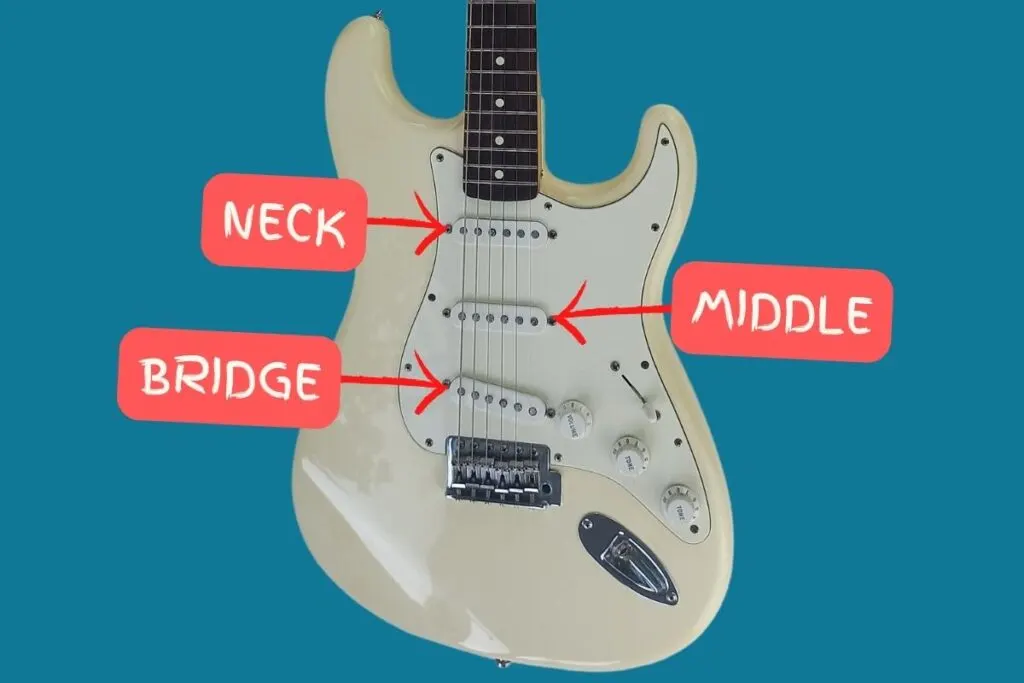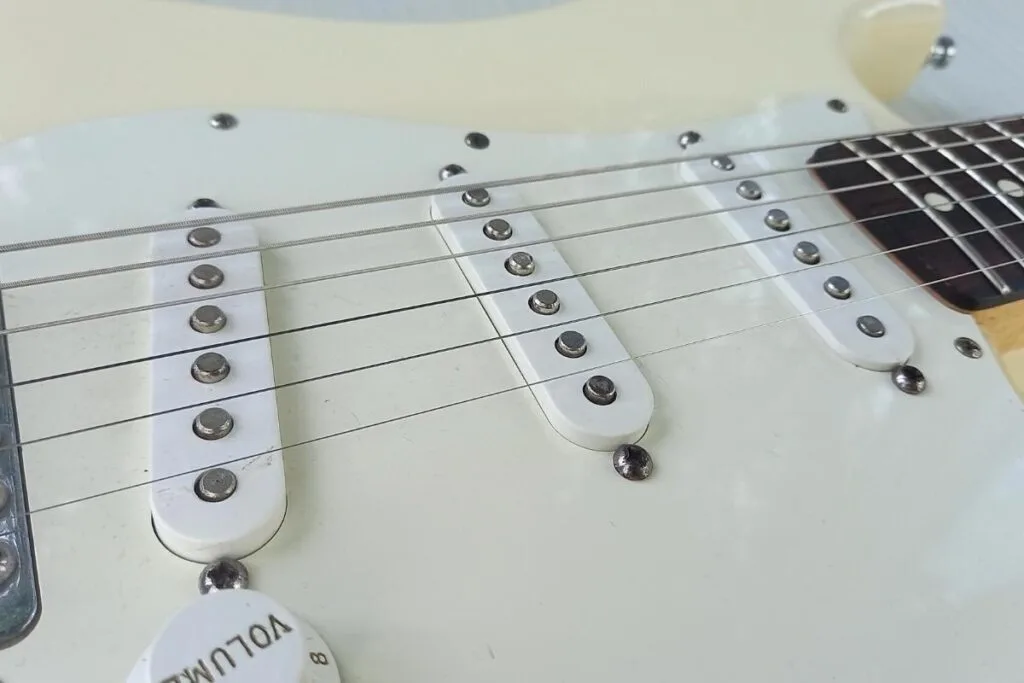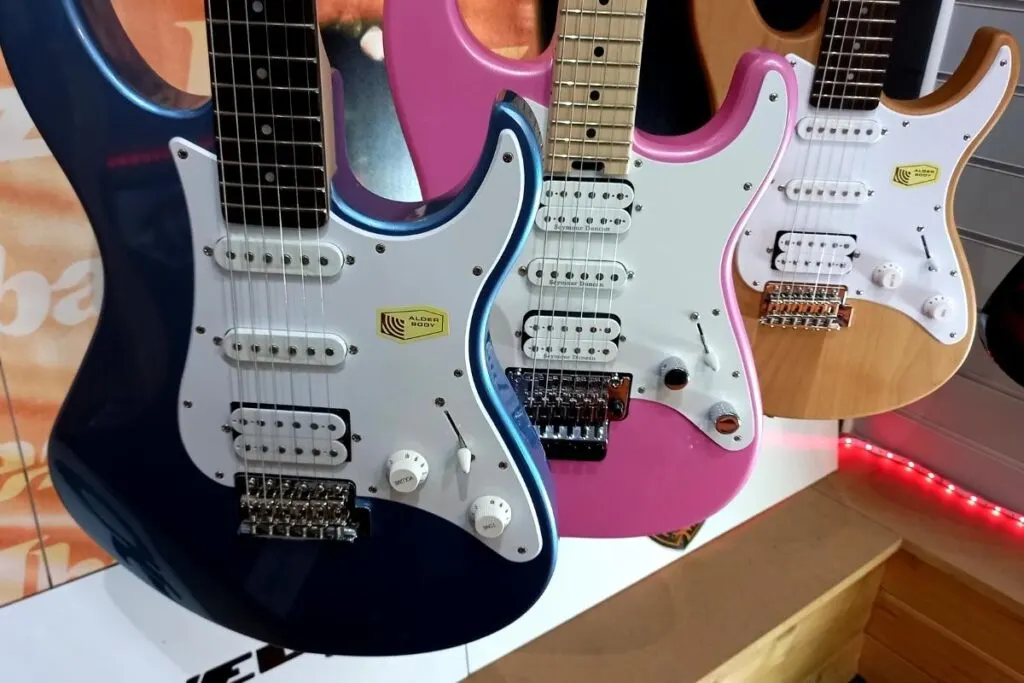If you’ve been looking at buying a guitar, you’ll probably have seen the terms “SSS” and “HSS” used to describe them and wondered what it means.
“SSS” and “HSS” refer to the types and positions of the pickups that are used on a guitar. The first letter means which pickup is at the bridge, the second is the pickup that’s in the middle, and the last is the pickup at the neck position. “S” refers to a single coil pickup, whereas “H” refers to a humbucker pickup.
So, “SSS” means that a guitar has three single coil pickups, one at the bridge, middle, and neck positions. “HSS” means that there is a humbucker at the bridge position, and single coils at the middle and neck positions.
But, what does this mean for you as a player? What are the pros and cons of each type? And, most importantly, what do they sound like?!
I’ve put this guide together to answer all the questions you could have about SSS vs HSS guitars in one place, so you can quickly make your mind up about which is best for you. At the end of this, you’ll be an expert on the different setups, and what they’re best for. Let’s get started!
What is an SSS guitar?
An “SSS” guitar has three single coil pickups, one in the bridge, middle, and neck positions. Read left to right, the different letters indicate the type of pickup (“S” meaning “single coil”) and their location (bridge, then middle, then neck).

The best example of an SSS guitar is the Fender Stratocaster, which debuted with this setup in the 1950s. Now, there are a few exceptions to the rule, but most Fender Stratocasters models (and their copies!) have an SSS pickup configuration. As such, the pickups used on SSS guitars are usually Stratocaster style single coils, as opposed to other types such as a P-90 single coil pickup.
Why all the single coil pickups?
So, what’s the point in using all single coil pickups? Wouldn’t it make more sense to use a bunch of different types of pickup to get as many sounds as possible? Yes, and also no!
The single coil pickups all sound different based on where they’re placed, and how they’re made. The bridge and neck pickups, for example, are made slightly differently which has a large impact on their sound. I have an article on neck vs bridge pickups that explains the differences in detail and lets you hear the difference for yourself.
As a quick summary, the pickups sound different because of the way their coils are wired and how the guitar strings vibrate. The strings vibrate less at the bridge and more at the neck, meaning there’s a weaker signal towards the bridge. To compensate for this, the pickup at the bridge is made stronger than the one at the neck. As a result, the pickup closer to the bridge has a sharper sound than the pickup at the neck, which sounds mellower and warmer.
Having the pickup in different locations where the tension differs allows you to have a wide range of sounds. So, even though SSS guitars only use single coils, there’s a massive amount of tonal options available to you, especially when you learn how to adjust the guitar’s controls!
What does an SSS guitar sound like? What’s it best used for?
When it comes to the sound of an SSS guitar, we’re really just talking about the sound of a single coil pickup. Single coil pickups have an instantly recognisable “vintage” sound. Even modern day single coils keep true to their design heritage and aim to create an authentic bright and plucky sound.
Because this article is focussing on SSS vs HSS, the main focus is going to be on the bridge pickup, namely the difference between single coil vs humbucker pickups.
Here’s a recording I made of the single coil bridge pickup on my Stratocaster.
As you can hear, single coil pickups have a bright crisp sound that’s clear and crisp, with plenty of high end. Various blues and jazz guitarists prefer the SSS configuration as it provides clarity and brightness when playing instrumentals or solos where articulation and precision are needed.
But, these guitars are no stranger to rock either. Guitar legends like Jimi Hendrix, Stevie Ray Vaughan, and Yngwie Malmsteem are known for their use of SSS guitars. Listen to how my Stratocaster sounds with some distortion.
What are the pros and cons of an SSS guitar?
SSS guitars have a wide range of tonal possibilities, thanks to their three pickup design. This means that you can get a wide range of sounds out of your guitar. From biting, clean articulation in the bridge position, to a mellow warmth in the bridge.
These guitars usually come with a five-way pickup selector, allowing you to select multiple pickups at once, giving you even more control over your sound.
So, whether you’re looking to stand out in a mix, or blend your guitar in with your band, you’ve got plenty of options available to you.

That being said, the Stratocaster style SSS pickups don’t have the same richness and ‘full’ sound the other pickups provide, meaning you’ll struggle to get a ‘big’ sound from your guitar. This can be a problem when it comes to playing music like jazz. The bold, woody tone of a P-90 pickup will sound much more natural than a Stratocaster-style single coil, although you can get most of the way there by using the neck pickup.
The most distinct disadvantage of the single coil is a constant noise known as the ’60 cycle hum’ (or 50 cycle if you’re in the UK). Due to how single coil pickups work, it’s sensitive to nearby electronic signals. These signals can interfere with your guitar’s signal, ultimately being heard when playing through an amp.
Generally speaking, SSS pickups have a thinner sound than an HSS guitar, and are susceptible to 60 cycle hum. They do, however, have a higher output and sound crisper and brighter than the humbucker of an HSS guitar.
Question: Do you prefer single coil or humbucker pickups? Let me know in the comments below!
What is a HSS guitar?
As I’ve mentioned, the term HSS refers to the type of coils and their positions; so an HSS is a guitar with single coil pickups in the middle and at the neck, and a humbucker at the bridge.
So, what’s a humbucker? It’s a type of pickup that was invented to “buck” the “hum” of the single coils. Essentially, a humbucker is two single coils engineered together to provide a noise-canceling effect. I’ve covered how this works fully in my article here.

As a result, a humbucker at the bridge has a fuller sound than a single coil, with less noise which makes it great for playing high-gain music like rock and metal.
Popular HSS guitars include the Fender American Professional and Performer models, as well as the Squier Classic Vibe.
What does an HSS sound like? What is it best used for?
HSS guitars have a lot of similarities with SSS guitars, as they both use single coil pickups in the middle and neck positions. So, they’ll still have the warm, mellow neck tones that work great for blues and jazz.
The main difference is the humbucker bridge pickup. This pickup sounds warmer and thicker than a single coil pickup, but with a lower output. It’s great for use in a high-gain signal, as it won’t produce the nasty humming that a single coil will.
Here’s a recording of the bridge pickup of my Les Paul (not a HSS guitar, but still has a humbucker in the bridge position!).
What are the pros and cons of a HSS guitar?
The main advantage of the humbucker at the bridge is that you cancel out the constant humming noise created by the single coil (60-cycle hum). As a result, the sound is more balanced and blended in the mix, making the guitar sound full and thick, which is ideal for rhythm guitar as it gives the impression of filling space.
However, the dynamic range of the HSS is less than the SSS as the humbucker at the bridge automatically blends the sound making it more balanced. The single coil at the bridge creates a brighter and warmer sound than the coil at the neck, meaning the range of tones to play around with is larger with an SSS.
Keep in mind that the HSS, although not as dynamic, is the most versatile configuration as it can handle clean and distorted tones better, making more ranges of sound available without becoming too unnecessarily noisy!
Can you convert HSS guitars to SSS guitars (or vice versa)?
If you’re not happy with your current setup, then it is possible to change the pickup configuration of your guitar – but it can be tricky.
The main issue is space. Most guitars have holes for the pickups cut into the body. So, if you have an SSS guitar and want to add a traditionally sized humbucker at the bridge and remove the single coil, you may find that the space is too small, and you’ll have to make some alterations first.
But, nowadays, you can get single coil sized humbuckers. So, you can still get the humbucker sound without having to cut into your guitar (or pay someone else to do it, which is always the safer option!)
On the other hand, swapping out a humbucker to a single coil is much easier, as you have more room. You’ll just need to make sure that the pickup is held in place and doesn’t wobble around. Again, it’s always best to get a professional to take a look.
But, like the single coil sized humbucker – there are humbucker sized single coil pickups! So, having the extra space gives you more options for single coils, like trying out a P-90 style pickup.
That’s not the only option, though. You can also modify your humbucker pickups to become “coil-split”, meaning that they can “split” into a single coil and back to a humbucker at the flick of a switch.
What other pickup configurations are there?
Various music styles and genres require different sounds and tones, meaning musicians prefer a collection of guitars with different pickup configurations. The most popular configurations besides the SSS and HSS are the following:
- HH: The HH refers to humbuckers at both the bridge and the neck, popular with the Gibson Les Paul, which gives rich, dark tones. The bridge has a clear and mellow sounds, whereas the neck is warm and dark. This setup is ideal for rock musicians playing lead and rhythm.
- SS: The SS refers to two single coils at both the bridge and the neck, popular with the Fender Telecaster, and will still produce the bright classical twangy tones of the SSS, but the missing middle coil means you have fewer combinations. The SS pickup selector only gives you three options; Bridge alone, neck alone or combined.
- HSH: The HSH refers to humbuckers at the neck and bridge but a single coil in the middle, popular with the Ibanez JEM. The single coil between the humbuckers provides the ideal balance as it won’t be too bright or warm, which will settle comfortably in the mix.
It’s worth mentioning that a three-coil configuration will provide you with the most versatility and combinations of tones. As you have three pickups, you have five combinations of tones to play around with. Whether you should use more single coils than humbuckers depends on your style and music preference!
If you intend on playing with high gain and want to avoid humming, it’s best to use a guitar with an “H” in the bridge position (HH, HSS, or HSH). But, if you want a bright, sharp sound, go for a guitar with an “S” in the bridge position (SS, SSS, or SHS)
Conclusion
Both SSS and HSS guitars have a lot of tonal options, due to their three-pickup configuration. The main difference between these two guitars are the pickups used in the bridge position: the single coil or the humbucker.
Single coils are brighter and sharper, resulting in a twangy vintage sound. In contrast, humbuckers provide more of a warm, balanced sound resulting in thicker darker tones. As well as this, they can handle high-gain signals better, as they reduce the amount of humming.


Conor is a music producer, multi-instrumentalist, and all-round enthusiast from the UK with over 15 years of experience. He’s the founder and sole-content creator for the roundtable audio blog and YouTube channel.
